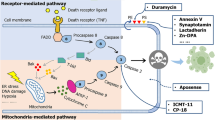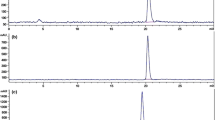Abstract
Purpose
We identified and validated [18F]-CP18, a DEVD (the caspase 3 substrate recognition motif) containing substrate-based compound as an imaging tracer for caspase-3 activity in apoptotic cells.
Procedures
CP18 was radiolabeled with fluorine-18 using click chemistry. The affinity and selectivity of CP18 for caspase-3 were evaluated in vitro. The biodistribution and metabolism pattern of [18F]-CP18 were assessed in vivo. [18F]-CP18 positron emission tomography (PET) scans were performed in a dexamethasone-induced thymic apoptosis mouse model. After imaging, the mice were sacrificed, and individual organs were collected, measured in a gamma counter, and tested for caspase-3 activity.
Results
In vitro enzymatic caspase-3 assay demonstrated specific cleavage of CP18. In vivo, [18F]-CP18 is predominantly cleared through the kidneys and urine, and is rapidly eliminated from the bloodstream. There was a sixfold increase in caspase activity and a fourfold increase of [18F]-CP18 retention in the dexamethasone-induced thymus of treated versus control mice.
Conclusions
We report the use [18F]-CP18 as a PET tracer for imaging apoptosis. Our data support further development of this tracer for clinical PET applications.






Similar content being viewed by others
References
Jacobson MD, Weil M, Raff MC (1997) Programmed cell death in animal development. Cell 88:347–354
Thompson C (1995) Apoptosis in the pathogenesis and treatment of disease. Science 267:1456–1462
Rimon G, Bazenet CE, Philpott KL, Rubin LL (1997) Increased surface phosphatidylserine is an early marker of neuronal apoptosis. J Neurosci Res 48:563–570
Olivetti G, Abbi R, Quaini F et al (1997) Apoptosis in the failing human heart. N Engl J Med 336:1131–1141
Krams SM, Martinez OM (1998) Apoptosis as a mechanism of tissue injury in liver allograft rejection. Semin Liver Dis 18:153–167
Darzynkiewicz Z (1995) Apoptosis in antitumor strategies: modulation of cell cycle or differentiation. J Cell Biochem 58:151–159
Blankenberg FG, Katsikis PD, Tait JF et al (1998) In vivo detection and imaging of phosphatidylserine expression during programmed cell death. Proc Natl Acad Sci U S A 95:6349–6354
Lahorte CMM, Vanderheyden J, Steinmetz N et al (2004) Apoptosis-detecting radioligands: current state of the art and future perspectives. Eur J Nucl Med Mo Imaging 31:887–919
Kemerink GJ, Liu X, Kieffer D et al (2003) Safety, biodistribution, and dosimetry of 99mTc-HYNIC-annexin V, a novel human recombinant annexin V for human application. J Nucl Med 44:947–952
Grütter MG (2000) Caspases: key players in programmed cell death. Curr Opin Struct Biol 10:649–655
Shi Y (2004) Caspase activation, inhibition, and reactivation: a mechanistic view. Protein Sci 13:1979–1987
Blankengerg FG, Norfray JF (2011) Multimodality molecular imaging of apoptosis in oncology. AJR Am J Roentgenol 197:308–317
Kim K, Lee M, Park H et al (2006) Cell-permeable and biocompatible polymeric nanoparticles for apoptosis imaging. J Am Chem Soc 128:3490–3491
Chu W, Zhang J, Zeng C et al (2005) N-benzylisatin sulfonamide analogues as potent caspase-3 inhibitors: synthesis, in vitro activity, and molecular modeling studies. J Med Chem 48:7637–7647
Zhou D, Chu W, Chen DL et al (2009) [18F]- and [11C]-labeled N-benzyl-isatin sulfonamide analogues as PET tracers for apoptosis: synthesis, radiolabeling mechanism, and in vivo imaging study of apoptosis in Fas-treated mice using [11C]WC-98. Org Biomol Chem 7:1337–1348
Zhou D, Chu W, Rothfuss J et al (2006) Synthesis, radiolabeling, and in vivo evaluation of an 18F-labeled isatin analog for imaging caspase-3 activation in apoptosis. Bioorganic & Medicinal Chemistry Letters 16:5041–5046
Nguyen Q, Smith G, Glaser M et al (2009) Positron emission tomography imaging of drug-induced tumor apoptosis with a caspase-3/7 specific [18F]-labeled isatin sulfonamide. Proc Natl Acad Sci U S A 106:16375–16380
Nguyen Q, Challapalli A, Smith G et al (2012) Imaging apoptosis with positron emission tomography: "Bench to bedside" development if the caspase 3/7 specific [18F] ICMT-11. Eur J Cancer 48:432–440
Thornberry NA, Rano TA, Peterson EP et al (1997) A combinatorial approach defines specificities of members of the caspase family and granzyme B functional relationships established for key mediators of apoptosis. J Biol Chem 272:17907–17911
Dutot L, Lécorché P, Burlina F et al (2010) Glycosylated cell-penetrating peptides and their conjugates to a proapoptotic peptide: preparation by click chemistry and cell viability studies. J Chem Biol 3:51–65
Nguyen J, Xie X, Neu M et al (2008) Effects of cell-penetrating peptides and pegylation on transfection efficiency of polyethylenimine in mouse lungs. J Gene Med 10:1236–1246
Kolb HC, Finn MG, Sharpless KB (2001) Click chemistry: diverse chemical function from a few good reactions. Angew Chem Int Ed 40:2004–2021
Rostovtsev VV, Green LG, Fokin VV et al (2002) A stepwise Huisgen cycloaddition process: copper(I)-catalyzed regioselective “ligation” of azides and terminal alkynes. Angew Chem Int Ed 41:2596–2599
Tornoe CW, Christensen C, Meldal M (2002) Peptidotriazoles on solid phase: [1–3]-triazoles by regiospecific copper(I)-catalyzed 1,3-dipolar cycloadditions of terminal alkynes to azides. J Org Chem 67:3057–3064
Cifone MG, Migliorati G, Parroni R et al (1999) Dexamethasone-induced thymocyte apoptosis: apoptotic signal involves the sequential activation of phosphoinositide-specific phospholipase C, acidic sphingomyelinase, and caspases. Blood 93:2282–2296
Chmielewski V, Drupt F, Morfin R (2000) Dexamethasone-induced apoptosis of mouse thymocytes: prevention by native 7alpha-hydroxysteroids. Immunol Cell Biol 78:238–246
Faust A, Hermann S, Wagner S et al (2009) Molecular imaging of apoptosis in vivo with scintigraphic and optical biomarkers—a status report. Anti-Cancer Agents in Med Chemistry 9:968–985
Zhao M, Zhu X, Ji S et al (2006) 99mTc-labeled C2A domain of synaptotagmin I as a target-specific molecular probe for noninvasive imaging of acute myocardial infarction. J Nuc Med 47:1367–1374
Zhao M, Li Z, Bugenhagen (2008) 99m Tc-Labeled duramycin as a novel phosphatidylethanolamine-binding molecular probe. J Nuc Med 49:1345–1352
Damianovich M, Ziv I, Heyman SN et al (2006) ApoSense: a novel technology for functional molecular imaging of cell death in models of acute renal tubular necrosis. Eur J Nucl Med Mol Imaging 33:281–291
Hoglund J, Shirvan A, Antoni G et al (2011) 18F -ML-10, a PET tracer for apoptosis: first human study. J Nucl Med 52:720–725
Edginton LE, Berger AB, Blum G et al (2009) Noninvasive optical imaging of apoptosis by caspase-targeted activity-based probes. Nat Med 15:967–973
Niers JM, Kerami M, Pike L et al (2011) Multimodal in vivo imaging and blood monitoring of intrinsic and extrinsic apoptosis. Mol Ther 19:1090–1096
Scabini M, Stellari F, Cappella P et al (2011) In vivo imaging of early stage apoptosis by measuring real-time caspase-3/7 activation. Apoptosis 16:198–207
Hickson J, Ackler S, Klaubert D et al (2010) Noninvasive molecular imaging of apoptosis in vivo using a modified firefly luciferase substrate. Z-DEVD-aminoluciferin Cell Death Differ 17:1003–1010
Maxwell D, Chang Q, Zhang X et al (2009) An improved cell-penetrating, caspase-activatable, near-infrared fluorescent peptide for apoptosis imaging. Bioconjug Chem 20:702–709
Xiong C, Yang Z, Zhang R et al (2009) 99mTc-labeled Ac-DEVD peptides as a substrate for measuring caspase activity. Adv Exp Med Biol 611:455–456
Bauer C, Bauder-Wuest U, Mier W et al (2005) 131I-labeled peptides as caspase substrates for apoptosis imaging. J Nucl Med 46:1066–1074
Walsh J, Kolb H (2010) Applications of click chemistry in radiopharmaceutical development. Chimia 64:29–33
Acknowledgments
We thank Dr. Kai Chen for contributing to the design of CP18. We thank James Secrest and Janna Arteaga for facilitating the animal experiments.
Conflict of Interest
The authors declare that they have no conflict of interest.
Author information
Authors and Affiliations
Corresponding author
Electronic Supplementary Material
Below is the link to the electronic supplementary material.
ESM 1
(PDF 710 kb)
Rights and permissions
About this article
Cite this article
Su, H., Chen, G., Gangadharmath, U. et al. Evaluation of [18F]-CP18 as a PET Imaging Tracer for Apoptosis. Mol Imaging Biol 15, 739–747 (2013). https://doi.org/10.1007/s11307-013-0644-9
Published:
Issue Date:
DOI: https://doi.org/10.1007/s11307-013-0644-9




